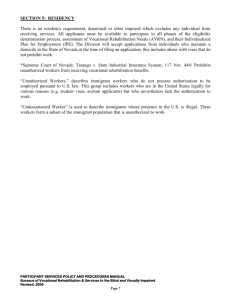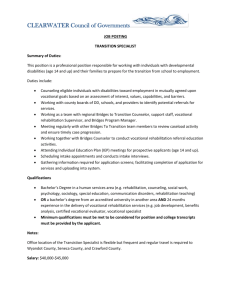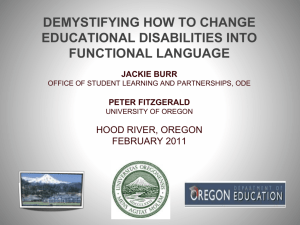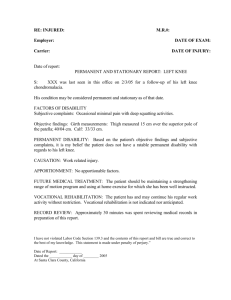- Commission For The Blind
advertisement
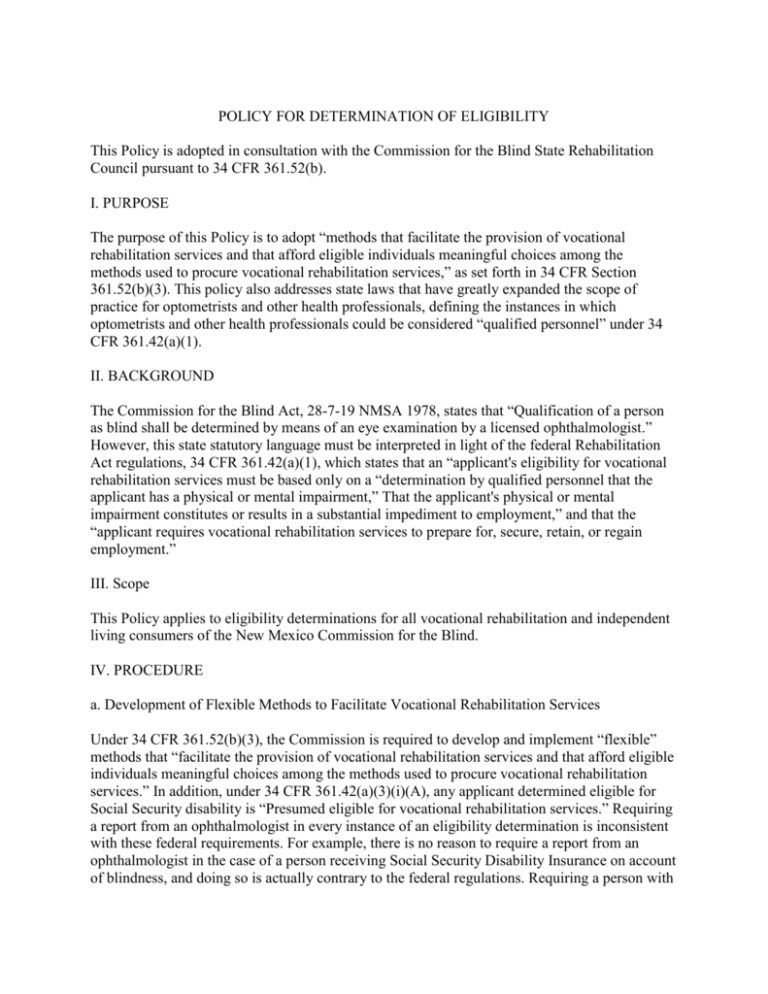
POLICY FOR DETERMINATION OF ELIGIBILITY This Policy is adopted in consultation with the Commission for the Blind State Rehabilitation Council pursuant to 34 CFR 361.52(b). I. PURPOSE The purpose of this Policy is to adopt “methods that facilitate the provision of vocational rehabilitation services and that afford eligible individuals meaningful choices among the methods used to procure vocational rehabilitation services,” as set forth in 34 CFR Section 361.52(b)(3). This policy also addresses state laws that have greatly expanded the scope of practice for optometrists and other health professionals, defining the instances in which optometrists and other health professionals could be considered “qualified personnel” under 34 CFR 361.42(a)(1). II. BACKGROUND The Commission for the Blind Act, 28-7-19 NMSA 1978, states that “Qualification of a person as blind shall be determined by means of an eye examination by a licensed ophthalmologist.” However, this state statutory language must be interpreted in light of the federal Rehabilitation Act regulations, 34 CFR 361.42(a)(1), which states that an “applicant's eligibility for vocational rehabilitation services must be based only on a “determination by qualified personnel that the applicant has a physical or mental impairment,” That the applicant's physical or mental impairment constitutes or results in a substantial impediment to employment,” and that the “applicant requires vocational rehabilitation services to prepare for, secure, retain, or regain employment.” III. Scope This Policy applies to eligibility determinations for all vocational rehabilitation and independent living consumers of the New Mexico Commission for the Blind. IV. PROCEDURE a. Development of Flexible Methods to Facilitate Vocational Rehabilitation Services Under 34 CFR 361.52(b)(3), the Commission is required to develop and implement “flexible” methods that “facilitate the provision of vocational rehabilitation services and that afford eligible individuals meaningful choices among the methods used to procure vocational rehabilitation services.” In addition, under 34 CFR 361.42(a)(3)(i)(A), any applicant determined eligible for Social Security disability is “Presumed eligible for vocational rehabilitation services.” Requiring a report from an ophthalmologist in every instance of an eligibility determination is inconsistent with these federal requirements. For example, there is no reason to require a report from an ophthalmologist in the case of a person receiving Social Security Disability Insurance on account of blindness, and doing so is actually contrary to the federal regulations. Requiring a person with bilateral ocular prostheses to see an ophthalmologist is likewise contrary to the requirement to adopt flexible methods to facilitate the provision of vocational rehabilitation services. In the case of a person with bilateral prostheses due to Anopthalmia or enucleation, a medical doctor, a physician’s assistant, or a nurse practitioner can reasonably and appropriately determine that an individual has a qualifying visual impairment. In such cases, requiring a report from an ophthalmologist would result in an unnecessary delay, and is contrary to the requirement to adopt flexible methods to facilitate provision of vocational rehabilitation services. b. Definition of Qualified Personnel In order to develop and implement flexible methods that facilitate meaningful choice among the methods to procure vocational rehabilitation services, The Commission for the Blind adopts the following definitions of qualified personnel, and determines that the following health care professionals meet the definition of qualified personnel under the circumstances specified: 1. Ophthalmologists when an ophthalmologist can reasonably and appropriately determine that an individual has a qualifying visual impairment. In the vast majority of instances, a report from an ophthalmologist can be used to reasonably and appropriately determine eligibility. In unusual circumstances where there is no known physiological or organic cause for the blindness, it may be necessary to obtain reports from other medical professionals, such as a neuroophthalmologist, a neurologist, or a psychiatrist. It may also be necessary to obtain reports from an optometrist as such reports may help to provide a more complete understanding of the applicant’s vision. 2. Optometrists when an optometrist can reasonably and appropriately determine that an individual has a qualifying visual impairment. In the majority of instances, a report from an optometrist can be used to reasonably and appropriately determine eligibility. This includes applicants with conditions such as Leber's congenital amaurosis, Stargardt's Disease, Best's Disease, Usher Syndrome, Marfan Syndrome, Age-related macular degeneration, glaucoma, retinitis pigmentosa, albinism, uveitis, microphthalmia, optic nerve hypoplasia, optic nerve atrophy, Aniridia, keratoconus, retinopathy of prematurity, retinoblastoma, and diabetic retinopathy. In some circumstances, including conditions such as a cortical visual impairment, a neurological visual impairment, or a conversion disorder, it may be necessary to obtain a report from an ophthalmologist, a neuro-ophthalmologist, a neurologist, or a psychiatrist. 3. Medical doctor, physician’s assistant, or nurse practitioner when a medical doctor who is not an ophthalmologist, physician’s assistant, or nurse practitioner can reasonably and appropriately determine that an individual has a qualifying visual impairment. In some instances, a report from such a medical doctor, physician’s assistant, or nurse practitioner can be used to reasonably and appropriately determine eligibility. This can include conditions where there is an obvious physiological or organic cause of the visual impairment, such as in the case of bilateral phthisis bulbi, bilateral Anopthalmia, bilateral enucleation, or extreme bilateral microphthalmia. 4. Disability examiner when a disability examiner is employed to make disability determinations for the Social Security Administration, and when a disability examiner has reviewed the medical evidence and determined that an individual has a visual impairment that qualifies the individual for Social Security Disability Insurance or Supplemental Security Income based on blindness. Approved this 19th Day of June, 2015 _________________________________ Thomas P. O’Brien Chair State Rehabilitation Council Commission for the Blind _________________________________ Greg D. Trapp, J.D. Executive Director Commission for the Blind
